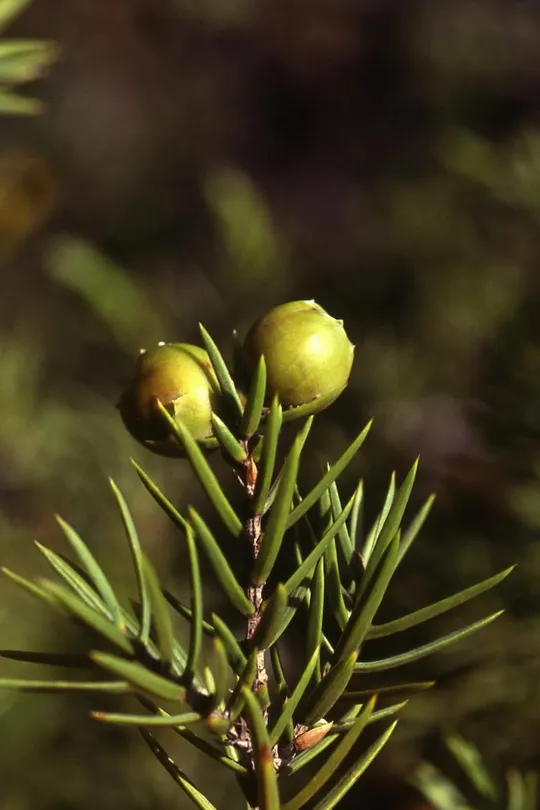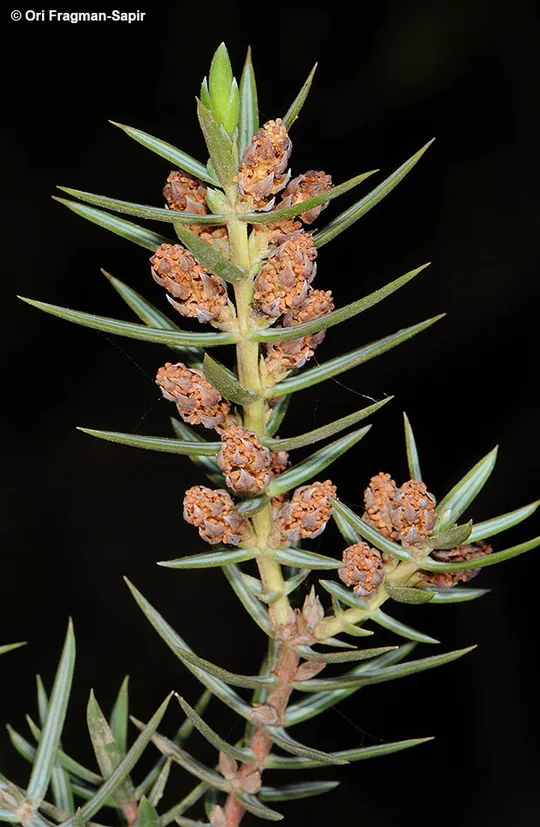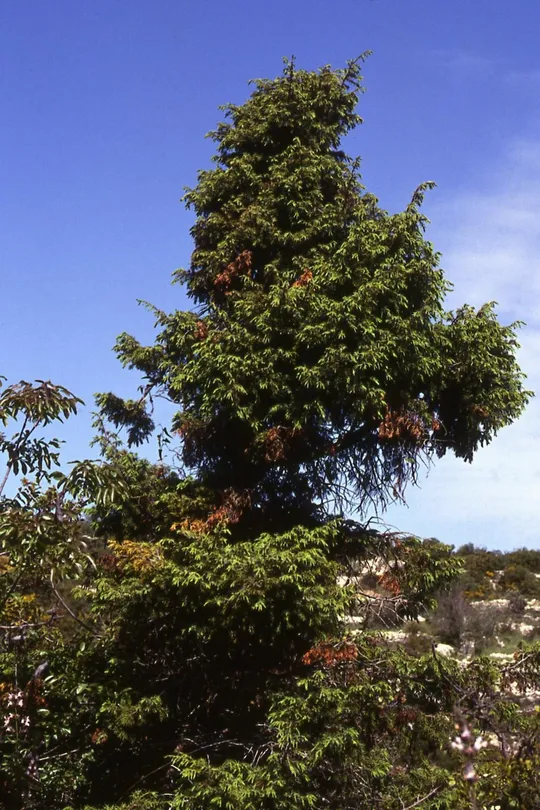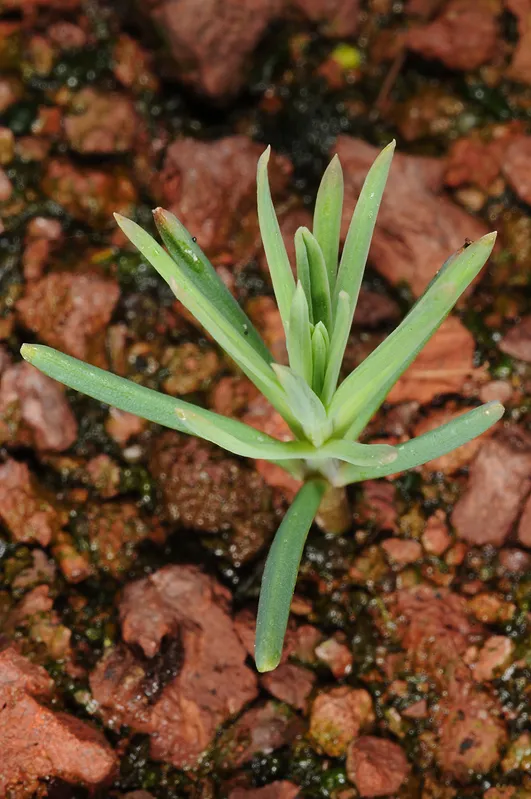Prickly Juniper, Brown-berried Juniper
Juniperus deltoides



Juniperus oxycedrus is an ornamental plant in southern Europe; there are several
varieties, including "weeping” varieties. Medicinal oils are produced from
its leaves and stems.
Juniperus oxycedrus grows in the Upper Galilee at a single site on Mount Shfanim
near Bet Ǧan. This
population, known for many years, is the only one in Israel, Jordan and the
Hermon. The British declared the site a forest reserve during the Mandate
period. It extends over 45 ha and is now included in the Mount Meron Nature Reserve.
The Juniperus range deviates slightly from the reserve boundaries. The
tree has not been found up to now on Mount Hermon or in the Golan Heights.
In Israel, Juniperus
oxycedrus grows at altitudes of 830-930 m on the Deir
Hanna rocky formation – soft and occasionally sandy dolomite. The soil is yellowish
marly rendzina. The plant association is Pinus halepensis-Juniperus
oxycedrus with Labiatae (Lamiaceae), Cistus and many Orchidea. It usually appears in patches
where the natural vegetation was destroyed or suppressed by branch cutting and
grazing (Rabinowitz-Wynn, 1986). In the Mediterranean Basin it is most common
at altitudes of 0- 2200 meters in disturbed sites where it replaces Mediterranean
forests and woodlands, on diverse substrates and not just on marl. It also it
accompanies Cedrus and other Juniperus forests at higher
altitudes.
The genus Juniperus consists of about 60 trees or shrub species that grow
mostly in the northern hemisphere. Only one species penetrates the mountains of
Africa. The distribution center of the genus is in the East Asian steppes and
the deserts of North America. Unlike many other conifers, J. oxycedrus can sometimes regenerate after cutting
or fire. Juniperus has a characteristic small, fleshy and unopened cone, prominently
colored (blackish, dark purple or reddish) which, when mature, is consumed by birds
and large mammals that disperse the seeds over long distances. In this trait it
differs from Cupressus, whose brown pine cone is large, heavy, dry and opens
up. Consequently, Cupressus seed dispersal is mainly local. This may be
the reason that Cupressus species have narrow ranges and the genus it differentiates
into many local species, while most of Juniperus species have a broad distribution.
In the genus Juniperus we distinguish two groups: those with scaly
leaves (e.g. Cupressus leaves) and thorny coniferous leaves. Apparently,
the scaly species developed from the coniferous species, as their seedling
leaves are coniferous, which points to their origin. In the New World, all
species are scaly, except for one, which probably invaded during the
Pleistocene period. In the Old World, the distribution center of the scaly
species is in Iran and Central Asia, and that of the coniferous species –
around the Mediterranean. J. oxycedrus belong to the thorny-coniferous dioecious
group. In this group, the
budding cones grow in the axil of the previous year's branches, unlike the
scaly monoecious group where the developing cones emerge at the ends of the
current year’s stems. In Israel, J. oxycedrus belong to the group of northern
species that reach the southern limit of their Middle Eastern distribution in
the Mount Meron block. (Schmida and Leshner, 2010).
J. oxycedrus has four subspecies, two
are coastal plants in the western Mediterranean that are sensitive to cold, and
two have a broad distribution: one has large fruits (ssp. macrocarpa)
and the other is the subspecies (ssp. oxycedrus) to which the population
in Israel belongs (Farjon, 2010).
Apparently Juniperus
oxycedrus maintains its stability over the years in
terms of both the dimensions of the area it occupies and the number of plants,
which is estimated at hundreds (M. Assaf survey, 1989). In 1980-1991 there was extensive
mortality of large trees in this population. Some of the trees looked infected
and brown. In the 1989 survey, it was noted that mortality began with the desiccation
of the treetop and descended to the lower section of the tree. To date, no
clear explanation has been given for this. The area is intensively grazed. The
plant is protected by law and grows in the Mount Meron Nature Reserve.
Juniperus oxycedrus population has to be monitored and efforts made to prevent
the reduction of the area covered by the Mount Meron Nature Reserve.
Juniperus oxycedrus
is found throughout the entire Mediterranean Basin from Spain
in the west to Israel, in areas where precipitation exceeds 500 mm. It invades
nearby areas where the forest was cut down and the natural vegetation
destroyed. J. oxycedrus penetrates the Irano-Turanian
area, from Turkey to the Caucasus and northern Iran. It is a major component of the evergreen
Mediterranean forest and woodland zone. In Lebanon, it is a common thorny shrub
below altitudes of 1250 m, in sub-forests of Pinus pinea.
Juniperus oxycedrus is a coniferous evergreen thorny shrub
or small tree, characteristic of the Mediterranean Basin. In Israel, it grows at
a single site in the Mount Meron block, is disjunct from its main distribution area,
and is the southernmost site of the species distribution.
שמידע, א. וי. לב-ארי. 1982. הצומח והיערות של דרום לבנון. רתם: 5: 60-61.
רבינוביץ-וין, א. 1986. סלע-קרקע-צומח בגליל. הקיבוץ המאוחד ורשות שמורות הטבע.
Farjon, A. 2010. A Handbook of the World's Conifers. Brill. Pp. 430-433.
Current Occupancy Map
| 1000 squre meter pixel | 5000 squre meter pixel | 10000 squre meter pixel | |
|---|---|---|---|
| number of observations | 0 | 0 | 0 |
| in total pixels | 0 | 0 | 0 |
| Family | Cupressaceae |
| Classification | On the endangered species list |
| Ecosystem | Mediterranean |
| Chorotype | Mediterranean |
| Conservation Site | Mount Shfanim near Bet Ǧan |
| Rarity |
1
6
6
|
|---|---|
| Vulnerability |
0
0
4
|
| Attractiveness |
0
1
4
|
| Endemism |
0
0
4
|
| Red number |
1
4.2
10
|
| Peripherality | N |
| IUCN category | DD EW EX LC CR EN VU NT |
| Threat Definition according to the red book | Endangered |
 Based on:
Based on:






